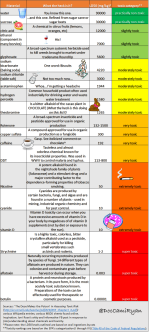I'd like to know if there is an underlying assumption of no glyphosate retention being assumed and if that is reasonable. I think researchers may model these things as having "half-lifes."
The serum half life of glyphosate in humans is about 3.1 hours, according to
this report (which studied patients who had attempted to commit suicide by drinking the stuff - only 3.2% succeeded, despite being in rural Sri Lanka, with access to only rudimentary medical care).
Thanks for this info. I think that serum half-life is not completely irrelevant but these things are way more complicated. We are discussing vaginal insertion of a tampon. So does glyphosate have any impact at all to pathyways in the vagina? Note that different chemicals are present in the vagina than elsewhere in the body. Different tissue differentiation, different hormones, even different micro-organisms, etc. Does any pathway or reaction produce output which could have retention in the body? What half-life do these new chemicals have? What kinds of toxicity or other side effects might they have?
To be open, I am skeptical that low levels of glyphosate have significant impact on this area of the body. I do think that there is not a lot of opportunity for retention of chemicals during menstruation. I also think that since there has been research on correlations between glyphosate and female-specific side effects, that the risk is low.
To me, the importance of the op is that there are unintended consequences of what we do and some of those consequences may be pervasive. We will observe such consequences in the most shocking, unusual places (such as a woman's vagina). Taken as a whole, there should be some human concern for risk, not necessarily for any one observation, but for the collective observation of the pervasiveness--that glyphosate is essentially "everywhere."
There are other observations of changes in Western health and in the world environment which are also pervasive. The root causes of some of these things are unknown or unproven. For example, increased incidence of cancers and decline of various animal populations throughout the world. I believe at least some of these things it will turn out were caused by unintended consequences of what humans do. I think it's important to stop and think, to be humble, not dismissive necessarily of every idea or we will not reach the proper conclusions.
bilby said:
Glyphosate just isn't that toxic to animals. That's why it is so popular - it has replaced herbicides like Paraquat, which were extremely toxic to animals, including humans.
View attachment 4595
http://www.geneticliteracyproject.org/2014/04/30/is-glyphosate-used-with-some-gm-crops-dangerously-toxic-to-humans/
LD50 is
one way to measure lethality which specifically we are NOT discussing in context and which we have said a couple of times is NOT being discussed in context. A chemical need not be lethal at concentration X to be harmful at concentration Y where Y << X. The ways in which harm is evidenced also need not be highly correlated to the ways in which lethality is evidenced in the LD50 chart. So the lethal concentration could create a coma and brain death where very low doses may harm some pathway in the kidneys or other organs. The lethal concentration may also harm the pathway in kidneys but the hypothetical brain death could occur first. Dose responses are also not linear.
An example is vitamin A toxicity. Vitamin A toxicity can include symptoms that affect the liver. For vitamin A toxicity you will observe some symptoms similar to jaundice because of liver dysfunction. You may observe yellow/orange skin as with jaundice. You may also observe hair loss. There are a number of other problems, too. Wikipedia lists 30 or so. However, if you look at an LD50 chart of vitamin A lethality you will see different kinds of symptoms such as unconsciousness, reproductive toxins, and convulsions.
LD50 of vitamin A is 2000, LD50 of glyphosate is 5600. However, a much lower dose than 2000 mg/kg of vitamin A over time can cause toxicity. For example, 1500IU/kg retinol can be toxic for children. IU for retinol is only .3 ug. The LD50 versus toxic dose is different by several orders of magnitude. To review:
LD50 (vit A) = 2000 mg/kg body weight
toxic dose (vit A) = 1500 IU/kg per day = 1500*.3ug/kg body weight per day = 1500*.3ug/kg body weight per day = 0.45mg/kg body weight per day.
So a single toxic dose (which would be done each day for quite a lot of days) is only ~= 1/5000th of the single lethal dose.

